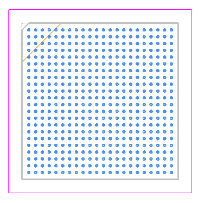5CEFA5F23I7N FPGAs: Features, Applications and Datasheet
2025-10-14 10:32:06 1533
5CEFA5F23I7N Description
The 5CEFA5F23I7N is an FPGA device from the Intel (formerly Altera) Cyclone V E family. It provides a balance of logic density, performance, and low power consumption for cost-sensitive and embedded applications. This FPGA contains approximately 77,000 logic elements, multiple megabits of on-chip RAM, DSP blocks for signal processing, and up to 240 general-purpose I/O pins. It operates on a 1.1V core voltage and supports a wide range of I/O standards including LVDS, LVTTL, and LVCMOS. The device is housed in a 484-pin FBGA package and is rated for the industrial temperature range from -40°C to +100°C.
5CEFA5F23I7N Features
Logic Elements: Approximately 77,000
Embedded Memory: Around 4.8 Mbits of block RAM
DSP Blocks: Integrated multipliers for high-speed arithmetic operations
I/O Pins: 240
Supported I/O Standards: LVDS, LVTTL, LVCMOS, and others
Core Voltage: Nominal 1.1V (tolerance ±3%)
Package: 484-ball FBGA (23 x 23 mm)
Temperature Range: -40°C to +100°C (industrial grade)
Low power consumption and cost-effective design
Compatible with DDR2/DDR3 memory interfaces
Ideal for reconfigurable logic, signal processing, and embedded control systems
5CEFA5F23I7N Applications
Industrial automation and motor control
Communication and networking systems
Digital signal processing (DSP) applications
Embedded control and monitoring systems
Interface bridging and protocol conversion
Medical instrumentation and imaging
Prototyping and educational FPGA development
Low- to mid-performance data processing systems
5CEFA5F23I7N CAD Model
Symbol

Footprint

3D Model


5CEFA5F23I7N Alternatives
5CEFA5F23C7N (different speed grade)
5CEFA7F23I7N (higher logic density)
Cyclone 10 LP FPGAs for lower power use
Cyclone V GX for applications needing transceivers
Xilinx Artix-7 series (similar density and performance)
Lattice ECP5 series (low-cost and compact alternative)
5CEFA5F23I7N Manufacturer
Intel Corporation is a global technology leader headquartered in Santa Clara, California, best known for designing and manufacturing advanced semiconductor products that power computing and connectivity worldwide. Founded in 1968 by Robert Noyce and Gordon Moore, Intel pioneered the development of the microprocessor, which revolutionized modern computing. Today, Intel’s product portfolio spans CPUs, GPUs, FPGAs, AI accelerators, and network and edge computing solutions. The company also plays a key role in advancing semiconductor process technology and manufacturing through its IDM 2.0 strategy, combining internal production, external foundry use, and its own Intel Foundry Services (IFS). Intel’s innovations enable breakthroughs across personal computing, data centers, cloud infrastructure, artificial intelligence, autonomous driving, and 5G communications, driving the world toward a smarter, more connected digital future.
5CEFA5F23I7N FAQs
What is the core voltage requirement for the 5CEFA5F23I7N?
The core operates at a nominal voltage of 1.1V, with an allowable range between 1.07V and 1.13V.
How many logic elements and I/O pins does this device provide?
It provides approximately 77,000 logic elements and 240 I/O pins.
Which memory and I/O interfaces are supported?
It supports DDR2 and DDR3 memory interfaces and common I/O standards such as LVDS, LVTTL, and LVCMOS.
What is the operating temperature range for this FPGA?
The device is rated for industrial temperatures from -40°C to +100°C junction temperature.
What does the suffix “I7N” indicate?
“I7N” refers to the industrial temperature grade and the device’s specific speed grade, meaning it is designed for higher performance and reliable operation in industrial environments.




